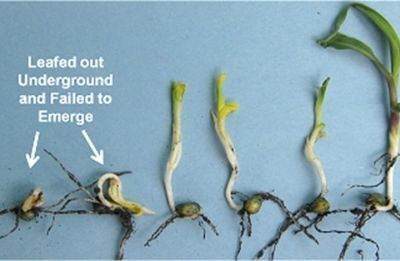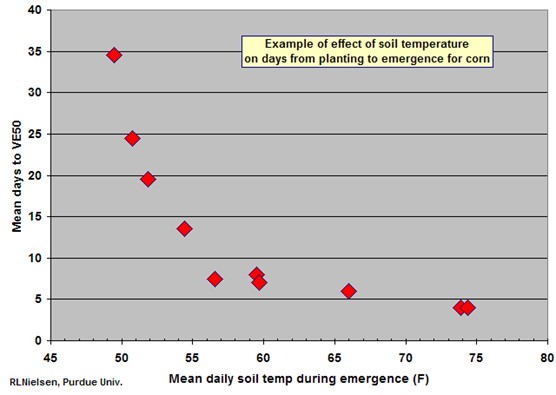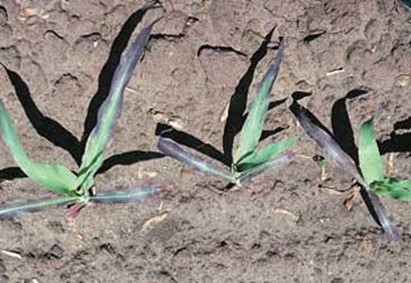 Image 1. Imbibitional chilling injury of seedling corn (Source: Monsanto)
Image 1. Imbibitional chilling injury of seedling corn (Source: Monsanto)
- Early planting increases full-season canopy photosynthesis, which can improve corn yields.
- Early planting also carries some additional risks that need to be managed.
- Key risks include delayed germination, slow growth rates, poor nutrient availability, disease issues, insect feeding, imbibitional chill injury, and frost damage.
Benefits of Early Planting
Long-term university studies have demonstrated that early planting provides the best opportunity for maximum corn yield. Early planting ensures that the plant can fully capitalize on solar radiation to drive growth and yield. Plants may reach reproductive stage more quickly and are less likely to pollinate under hot, dry conditions. Early planting helps capitalize on management scenarios involving high plant populations, full-season hybrids, and high fertility. Planting early also typically results in earlier harvest of grain at lower moisture levels, which can lead to lower drying costs and open timely opportunities for fall fertilizer applications, successful cover crop establishment, fall herbicide applications and fall tillage.
The optimal planting date varies by latitude, but generally falls between April 5 and May 5 for the central and northern corn belts. When planting is delayed, yield penalties begin to accumulate quickly each day after May 15. Early planting into cool, wet soil also carries some down-side production risks that will need to be managed to ensure success. What follows are some early planting considerations for corn.
1) Soil Temperature
Germination is driven by water absorption into the seed during the first 48 hours after planting, a process called imbibition. If rainfall occurs and soil temperatures drop much below 50°F during this critical first 48-hour period, the risk increases for imbibitional chilling injury and cold stress. Chilling injury ruptures cellular membranes, causing a host of negative symptoms, including aborted radicals and coleoptiles, premature leafing out underground, corkscrewing of the coleoptile, death of the seminal root system, and a deformed mesocotyl (see Image 1).
Germination may take as long as 12 days at soil temperatures of 55° F. At even cooler temperatures, germination may be delayed and uneven, which has shown to reduce yield due to the competitive effects of neighboring corn plants (see image 2). Soil temperatures can vary quite a bit from field to field. Before planting, be sure to check actual soil temperature and the forecast for the next several days. Whenever possible, avoid ‘beating the rain’ scenarios and strive to plant when temperatures are expected to remain warm and stable after planting and soil conditions are favorable for germination.

Image 2. Effect of soil temperatures on days from planting to emergence of corn (source RL Nielsen, Purdue University, 2015)
2) Frost and Freeze Injury
While foliar frost injury can appear dramatic on young corn plants, the injury is usually cosmetic and the plant can make a full recovery. The reason for this is that stalk internodes begin to elongate just prior to V5 and eventually push the corn growing point above the soil surface by V6. Prior to V6, the growing point is underground and generally protected from frost unless the temperature falls well below 30°F. Extended cold temperatures can penetrate underground and damage the growing point. If the growing point appears discolored or mushy, the plant may not recover.
3) Seedling Diseases
Wet soils and conditions that reduce seedling germination and growth rates can promote infection by seedling pathogens such as Pythium, Fusarium and Rhizoctonia. In general, cool, wet conditions are favorable for Pythium infection, whereas warmer temperatures favor infection by Fusarium and Rhizoctonia. Seed treatment fungicides that include metalaxyl or mefanoxam and another broad-spectrum active ingredient should provide up to three weeks of protection after planting against these seedling diseases. Some fungicides are also labeled for in-furrow application, which may provide higher loading rates and extend the window of protection provided by seed treatments. Chronic wet conditions and factors that delay seedling germination and growth after planting may still overwhelm these defenses.
4) Early Season Insects
Early planted corn that experiences delayed germination and slow growth rates may be more subject to damage by below-ground feeders like wireworms, white grubs, and seed corn maggot. The small size and slow plant growth rate extend the potential window of feeding injury by these insects and makes the plant less capable of recovering or outgrowing the damage. By contrast, early planted corn may entirely avoid risks from migratory insects like black cutworm, because the plants have often grown beyond the vulnerable stage by the time the pest reaches active levels. High rates of insecticide seed treatments or in-furrow soil-applied products in at-risk fields, will provide protection from these early season pests.
5) Nutrient Availability
Slow growth rates and cool temperatures can restrict early season nutrient availability, leading to temporary deficiency symptoms like purple and yellow foliage (see Image 3). Starter or pop-up fertilizers, which place nutrient in close proximity to the seedling, may help to alleviate some of these early season symptoms. Profitable yield response to starter fertilizer is more likely in challenging soils, no-till systems, and nutrient-deficient soils.

Image 3. Purple corn plants due to cold stress and possible short-term phosphorus deficiency. (Source: OMAFRA)
Summary of Early Planting Recommendations.
- Plant as early as feasible within the optimal window.
- Select a full-season hybrid with tall stature to capitalize on solar radiation.
- Use a premium seed treatment fungicide and insecticide to protect against early season threats, and scout for emerging threats.
- Use the high end of the range of optimum populations for the soil type and hybrid.
- Consider a starter or pop-up fertilizer application to alleviate early season nutrient availability issues.